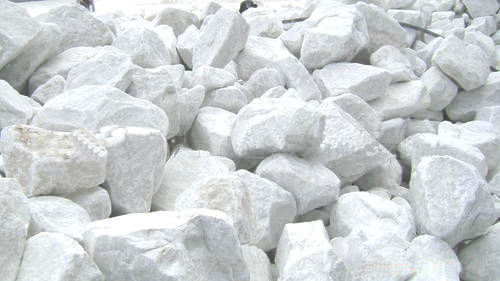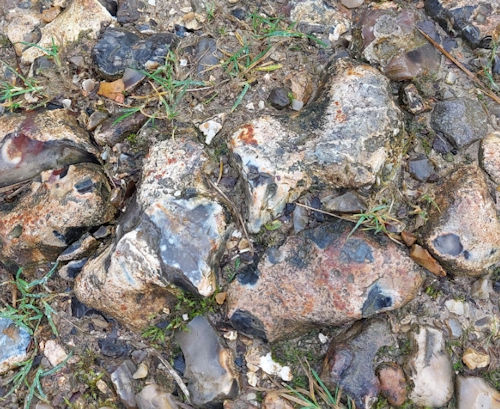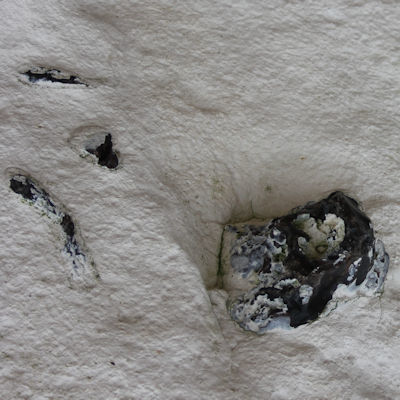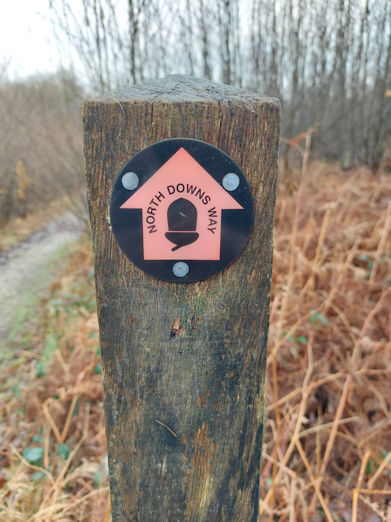Kings Wood sits on the North Downs - a ridge of chalk hills stretching for over a hundred miles from Farnham in Surrey to the White Cliffs of Dover

Chalk is a pure white limestone which is formed from the remains of tiny marine organisms that lived and died in the seas that covered much of Britain around 70 to 100 million years ago. When they died, their bodies fell to the sea bed and compressed together forming the rock we see today. Chalk can appear in large structure such as cliffs, or as smaller stones often used ornamentally.

Hang on a minute… Chalk?
I regularly walk my dogs round Kings Wood many times each week. We rarely if ever see any soft white easy-to-crumble chalk as we og. But we do see a lot of hard flints of various colours, just like these ones here. What’s going on in Kings Wood??

This EarthCache will show you why although the North Downs are widely known a range of chalk hills, you don’t always see chalk
Flint Formation
There is some controversy in the geological world about the exact details of how flint foms, but in general terms it is thought that..
Sedimentary rocks are formed from the bodies of tiny marine organisms. When these creatures died they fell to the bottom of the sea and piled up. However not all marine organisms are alike. The bodies of plankton contain a lot of calcite which forms the white chalk. However sponges and radiolarians contain much more silica in their bodies.
As the dead animal bodies piled up and decomposed, hydrogen sulphide formed from the decomposing organic material diffused upwards where it came into contact with oxygen diffusing downwards from the water column above. Where they met the hydrogen sulphide was oxidised to sulphate, and the hydrogen ions generated lowered the local pH. This dissolved some of the chalk and thereby increased the concentration of carbonate ions which acted as a seeding agent for the precipitation of silica. Which went on to form the flints we see today
And… As the tiny marine organisms fell to the sea bed they didn’t form sedimentary rocks immediately. They formed deep layers of slurry-like material in which all sorts of larger creatures burrowed. Their burrows could be quite deep and branching, and when the creature which dug them died they acted as pathways up which hydrogen sulphide could rise, giving preferential pathways for chemical reactions to occur.
Flint formed within these old burrows often has a nodular shape which reflects these burrow systems.

Hang on a minute… That gives us chalk with loads of flints inside it. But that’s not what we see here, is it?
Chalk is predominantly calcite – calcium carbonate. Flint is predominantly quartz – silicon dioxide. Chalk is relatively soft; flint relatively hard. Try standing on a bit of flint and then standing on a bit of chalk…
So with that in mind

Find the upright footpath marker sign bearing the “North Downs Way” symbol. (it’s rather obvious). Now look at the ground of the path around this signpost
Do you see predominantly chalk or flint?
What size are the stones embedded in the ground (not the loose ones)
Describe the texture of the stones. Are they intact or are they broken open?
Now go along and up the path to the marked waypoint at N 51° 12.856 E 000° 55.682. Look across to the bank on the left (north)( you can see examples closer, but this waypoint gives the best example in the area of what we want to see)
Do you see predominantly chalk or flint in the bank?
What size are the stones embedded in the bank (not the loose ones)
Describe the texture of the stones. Are they intact or are they broken open?
How does the appearance of the stones in the bank differ from those in the path? Why do you thik there might be this difference?
Optional…
Add a photo to your log. This might be of yourself or of a personal item or something bearing your caching name.
Logging your find
Please send me your answers via geocaching.com then log your find. If there are any issues with your answers I will get back to you.
******************
The landowner (Forestry Commission East England) does not assess the suitability or safety of the cache location. The cache placer and the cache finder have a responsibility to take reasonable precautions to protect their own safety and the safety of others. Hazards observed at or on route to the cache location should be reported to the cache owner. The Cache has been placed in accordance with the Forestry Commission East England agreement
******************